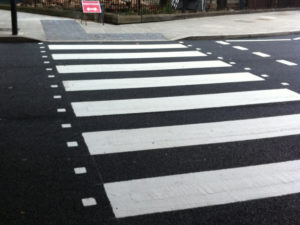Pedestrian Crossing Marking
 In 2012, pedestrian deaths rose to their highest level since 2006, increasing by 6.4 percent from 2011 to a total of 4,743 pedestrian fatalities. Injuries rose by 10 percent during the same time period. Furthermore, pedestrian deaths now make up 14 percent of the total traffic deaths in the U.S., up from 11 percent in 2011. This is partly the result of decreasing motorist deaths and increasing amounts of people walking for transportation and recreation.
In 2012, pedestrian deaths rose to their highest level since 2006, increasing by 6.4 percent from 2011 to a total of 4,743 pedestrian fatalities. Injuries rose by 10 percent during the same time period. Furthermore, pedestrian deaths now make up 14 percent of the total traffic deaths in the U.S., up from 11 percent in 2011. This is partly the result of decreasing motorist deaths and increasing amounts of people walking for transportation and recreation.
To combat the rise in pedestrian injuries and fatalities and create more walkable communities, there have been toughening laws regarding the circumstances when a motorist must stop or yield to a pedestrian crossing at an uncontrolled crosswalk. An uncontrolled crosswalk typically means that a traffic control device is either not in place or operation to dictate pedestrian movement.
Pedestrian Crossing
A marked crosswalk can benefit pedestrians by directing them to cross at locations where appropriate traffic control, including traffic signals or adult school crossing guards, either currently exist or can be provided. However, marked pedestrian crosswalks, in and of themselves, do not slow traffic or reduce pedestrian crashes.
It may be helpful to install marked crosswalks at signalized intersections or locations where crosswalks are typically marked, at key crossings in neighborhoods with designated school walking routes, and at certain types of uncontrolled crossings.
There are several reasons to install marked crosswalks, a few were to indicate a preferred pedestrian crossing location, to alert drivers to an often-used pedestrian crossing and to indicate school walking routes.
Crossing facilities fall broadly into three types;
- Uncontrolled crossing, often with a central refuge island
- Controlled Zebra crossing, with black& white road markings and amber flashing beacons
- Controlled Signalised crossing, with a pushbutton facility for the pedestrian
It should be noted that crossings are an amenity to aid access and make it easier to cross a road.
Based on the National Roads Authority Pedestrian Crossing Specification and Guidance, whena new crossing is installed temporary signs should be provided indicating a “newroadlayout”for refuge islands or “new pedestrian crossing” for zebra and signal
Controlled crossings.
These temporary signs should be removed after six months when the term “new pedestrian crossing” is no longer appropriate. Zig-zag markings should be provided on both the approachesto and exits from Zebra crossings and signal‐controlled crossings.
In mostcases, eight zigzag markings, covering a distance of approximately 16m should be provided on each approach and exit. This is to prevent parking which may restrict pedestrian/ driver inter-visibility. How ever, conditions on site such as parkings pace needs may make this difficult to achieve, and insuchcases, the designer should consider the circumstances and design the mostsuitable layout. At Zebra crossings this minimum can be reduced to Markings on the crossing exits if absolutely necessary, but the approaches must be keptat markings.
Contact us
 Phone Call |
 Text Message |
 |







